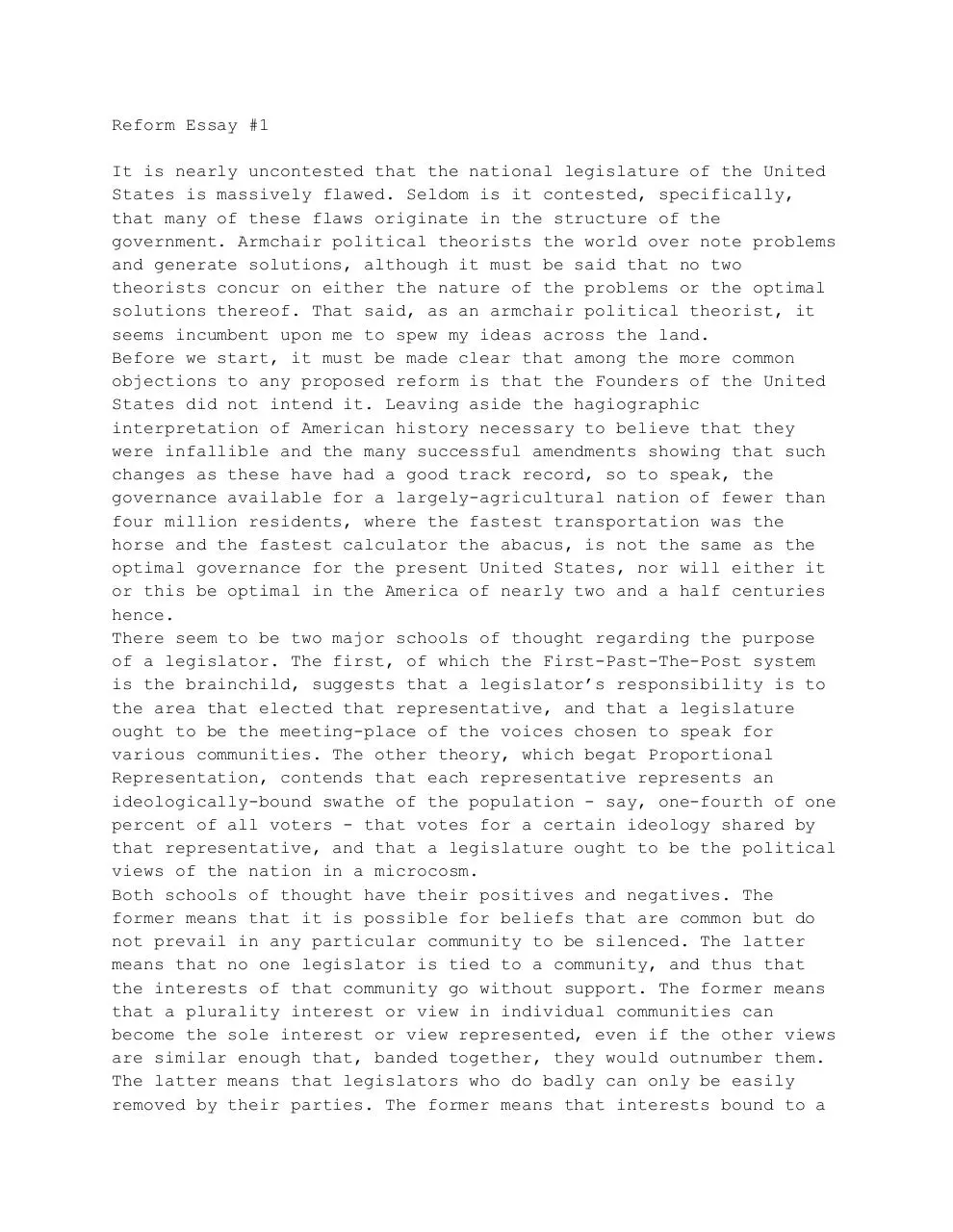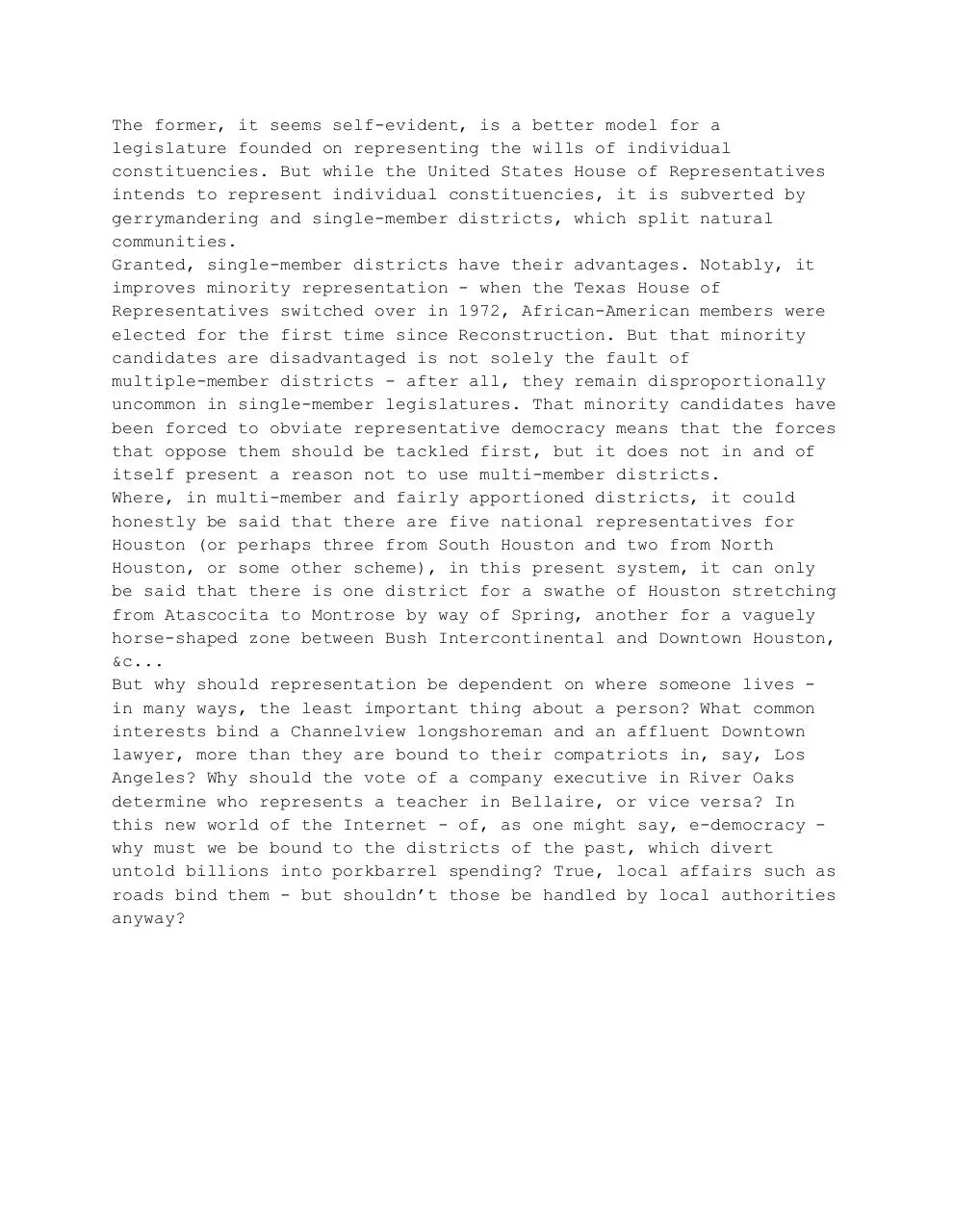ReformEssay1 (PDF)
File information
This PDF 1.4 document has been generated by / Skia/PDF, and has been sent on pdf-archive.com on 06/02/2016 at 01:47, from IP address 73.6.x.x.
The current document download page has been viewed 591 times.
File size: 64.97 KB (3 pages).
Privacy: public file



File preview
Reform Essay #1
It is nearly uncontested that the national legislature of the United
States is massively flawed. Seldom is it contested, specifically,
that many of these flaws originate in the structure of the
government. Armchair political theorists the world over note problems
and generate solutions, although it must be said that no two
theorists concur on either the nature of the problems or the optimal
solutions thereof. That said, as an armchair political theorist, it
seems incumbent upon me to spew my ideas across the land.
Before we start, it must be made clear that among the more common
objections to any proposed reform is that the Founders of the United
States did not intend it. Leaving aside the hagiographic
interpretation of American history necessary to believe that they
were infallible and the many successful amendments showing that such
changes as these have had a good track record, so to speak, the
governance available for a largelyagricultural nation of fewer than
four million residents, where the fastest transportation was the
horse and the fastest calculator the abacus, is not the same as the
optimal governance for the present United States, nor will either it
or this be optimal in the America of nearly two and a half centuries
hence.
There seem to be two major schools of thought regarding the purpose
of a legislator. The first, of which the FirstPastThePost system
is the brainchild, suggests that a legislator’s responsibility is to
the area that elected that representative, and that a legislature
ought to be the meetingplace of the voices chosen to speak for
various communities. The other theory, which begat Proportional
Representation, contends that each representative represents an
ideologicallybound swathe of the population say, onefourth of one
percent of all voters that votes for a certain ideology shared by
that representative, and that a legislature ought to be the political
views of the nation in a microcosm.
Both schools of thought have their positives and negatives. The
former means that it is possible for beliefs that are common but do
not prevail in any particular community to be silenced. The latter
means that no one legislator is tied to a community, and thus that
the interests of that community go without support. The former means
that a plurality interest or view in individual communities can
become the sole interest or view represented, even if the other views
are similar enough that, banded together, they would outnumber them.
The latter means that legislators who do badly can only be easily
removed by their parties. The former means that interests bound to a
particular area, even if they are despised by the country at large,
can be represented. The latter necessitates large parties and
disadvantages nonpartisan but popular candidates. And so on, and so
forth...
It seems likely that no system of government yet designed will both
perfectly represent the political views of the populace and produce
the optimal results for the purposes of good governance, even when
the two are in concord indeed, it is unlikely that any system will
successfully do either one. That said, there are nevertheless
improvements to be made to the present system.
While the former view the view of FPTP is massively prevalent in
the United States government, the alternative also makes good points
and deserves a seat at the table. And what better place than the
Senate, that great Proteus of the government first the voice of the
state legislatures, then that of the people of the various states,
with its elections arrhythmically staggered in an odd 2/3 time
signature. In truth, the states are strange choices for electoral
districts except for a few examples, too small for a viable
regional identity, yet too large for a local one, usually too
heterogenous to represent a specific community or type of community
yet too homogenous to be reasonably competitive, and nowhere near
proportional, with the residents of Wyoming having more than sixty
times the electoral power of an equivalent quantity of Californians.
What better solution than to replace the entire thing with a system
which represents all Americans equally, is founded on a national
identity rather than any smaller one (or, perhaps, if necessary, a
number of regional interests that elect national representatives),
and is exactly as heterogenous or homogenous as the country? Granted,
such a system would be illfitting for the endall and beall of the
legislature but its consistency of results make it nearlyideal as
an upper house.
And what of the lower house?
Political factions are fractal. There are two schools of thought
regarding how a district ought to be designed that a district ought
to reflect some kind of natural community, and that a district ought
to be designed so that it changes with the nation. The extent of the
former would be a district filled with homogenous electors, seldom
changing its political affiliation only when the mass views or
party loyalty of the public changed, as in the American South between
1960 and 1972. The latter suggests a legislature that vacillates from
one supermajority to another, according to the vicissitudes of the
electorate amplified to staggering crests and troughs.
The former, it seems selfevident, is a better model for a
legislature founded on representing the wills of individual
constituencies. But while the United States House of Representatives
intends to represent individual constituencies, it is subverted by
gerrymandering and singlemember districts, which split natural
communities.
Granted, singlemember districts have their advantages. Notably, it
improves minority representation when the Texas House of
Representatives switched over in 1972, AfricanAmerican members were
elected for the first time since Reconstruction. But that minority
candidates are disadvantaged is not solely the fault of
multiplemember districts after all, they remain disproportionally
uncommon in singlemember legislatures. That minority candidates have
been forced to obviate representative democracy means that the forces
that oppose them should be tackled first, but it does not in and of
itself present a reason not to use multimember districts.
Where, in multimember and fairly apportioned districts, it could
honestly be said that there are five national representatives for
Houston (or perhaps three from South Houston and two from North
Houston, or some other scheme), in this present system, it can only
be said that there is one district for a swathe of Houston stretching
from Atascocita to Montrose by way of Spring, another for a vaguely
horseshaped zone between Bush Intercontinental and Downtown Houston,
&c...
But why should representation be dependent on where someone lives
in many ways, the least important thing about a person? What common
interests bind a Channelview longshoreman and an affluent Downtown
lawyer, more than they are bound to their compatriots in, say, Los
Angeles? Why should the vote of a company executive in River Oaks
determine who represents a teacher in Bellaire, or vice versa? In
this new world of the Internet of, as one might say, edemocracy
why must we be bound to the districts of the past, which divert
untold billions into porkbarrel spending? True, local affairs such as
roads bind them but shouldn’t those be handled by local authorities
anyway?
Download ReformEssay1
ReformEssay1.pdf (PDF, 64.97 KB)
Download PDF
Share this file on social networks
Link to this page
Permanent link
Use the permanent link to the download page to share your document on Facebook, Twitter, LinkedIn, or directly with a contact by e-Mail, Messenger, Whatsapp, Line..
Short link
Use the short link to share your document on Twitter or by text message (SMS)
HTML Code
Copy the following HTML code to share your document on a Website or Blog
QR Code to this page

This file has been shared publicly by a user of PDF Archive.
Document ID: 0000338067.